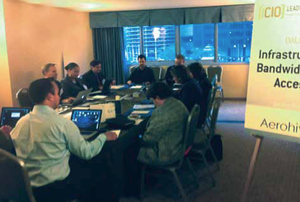Equipping the 21st Century Classroom

Although many of us dislike the term “21st century,” we can all agree that the notion behind it—the need to reform education to meet today’s and tomorrow’s learners—is still valid. And while most districts are just at the cusp of figuring out what 21st century learning is and how to deliver it, the technology leaders at the SchoolCIO Leadership Summit in Chicago have already begun figuring out some of the key elements: providing more bandwidth, focusing on resources, and working with leadership to get everyone on board.
Q The 21st Century Classroom is less about products and more of a mindset.
Technology is such a fast-moving target. Increasingly our focus is less about adding more devices, which we are challenged to find funds to purchase, and more about providing services that teachers and students can consume. Examples of this include pervasive wireless, a learning management system, email, and BYOD support. There is still a very valuable role for interactive whiteboards, projectors, etc., but the roles are more supportive. Those devices also tend to be more teacherfocused and less learner-focused.
—Steve Young, CTO, Judson (TX) ISD
We know what we expect from our students in terms of 21st century skills, but who can predict what technology will be available next year and beyond? We have started playing around with defining the functions of different types of technology and then identifying how each function can support 21st century instruction. For example laptops can be used to access and produce information, collaborate, and access simulations. If we develop lessons that take advantage of these functionalities, then—when the next laptop-like device comes along (e.g, the iPad?)—we will know how to use it in the classroom.
—Rick Cave, director of technology, West Windsor-Plainsboro (NJ) Regional School District

“We stay away from the term 21st century. It’s overused, a cliché. We say today’s learners.”
—Paul Sanfrancesco
Are any products essential—now or in the future—for a 21st Century Classroom?
When we surveyed our students at the end of last year, 99 percent said they use technology outside of school but only 72 percent said they use it in their classes. A large majority said they would like teachers to use online tools to support them outside of the normal school day. The key ingredients to this are devices (BYOD or district-provided), wireless connections, Internet access, and an LMS or other means of collaboration. Oh yeah, and lots of professional development and support.
Tools and ideas to transform education. Sign up below.
—Steve Young
A mobile device for every student; bandwidth, bandwidth, bandwidth; moving from print to digital resources; and teacherfriendly data tools and easy access.
—Jean Tower, director of technology, Public Schools of Northborough and Southborough, MA
Lots and lots of bandwidth, both wireless and Internet. Wireless connectivity is the backbone to one-to-one and BYO initiatives. But we also need wireless bandwidth to support communication between devices, including projectors and HDTVs.
—Rick Cave
Personalized learning plans for each and every learner, resources that meet specific needs and assess learners using the right tools with appropriate real-time student data, and cutting-edge assistive technology so that every student can learn. Technology may be able to beam us from school to school and class to class. Certainly, the need will continue to grow for increasing bandwidth.
—Sheryl R. Abshire, CTO, Calcasieu Parish (LA) Public Schools
Everything is moving to the Web. Lots of bandwidth is needed! We have doubled our bandwidth about four times in the last five years.
—Alice Owen, division director of technology, Irving (TX) ISD

How are learning spaces changing to accommodate blended/ online learning, flipped classes, collaborative projects, and student-centered learning?
Learning spaces need to be more flexible so that we can easily and quickly create spaces for small working groups or use the space more appropriately for the activities that support learning. We see a future where the library becomes the digital center of the school.
—Jean Tower
Learning spaces are no longer limited to the classroom. Hallways, cafeterias, courtyards, and playgrounds are all wireless. We can facilitate learning anywhere!
—Paul Sanfrancesco, director of technology, Garnet Valley (PA) School District
‘‘Every student needs his or her own device. We don’t share pencils; we shouldn’t share laptops.
—Alice Owen
